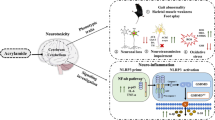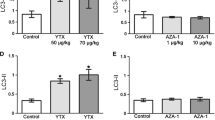Abstract
Acrolein, an unsaturated aldehyde, is an environmental toxin known to inhibit mitochondrial electron transport chain in brain and induce lipid peroxidation and apoptosis. However, the nature of the effects of acrolein on cardiac function and myocardium is not known. The objective of this study is to examine whether acrolein induces apoptosis in cardiomyocytes and alters cytosolic calcium concentration and the intracellular oxygen free-radical levels. Adult mouse cardiomyocytes exposed to 1 μmol/l of acrolein showed a marked increase in the intracellular oxygen free-radicals and calcium concentration, by 12- and 2-fold, respectively, compared to the resting value. Moreover, the cardiomyocyte viability decreased significantly in a dose-dependent manner by treatment with 25, 50, and 100 μmol/l of acrolein compared to controls. Morphological changes and DNA laddering typical of apoptosis were found in acrolein-exposed cardiomyocytes. Our finding suggested that acrolein caused apoptotic death of adult mice cardiomyocytes by increasing intracellular oxygen free-radicals and calcium concentration.




Similar content being viewed by others
References
Stevens, J. F., & Maier, C. S. (2008). Acrolein: sources, metabolism, and biomolecular interactions relevant to human health and disease. Molecular Nutrition & Food Research, 52, 7–25.
Uchida, K., Kanematsu, M., Morimitsu, Y., Osawa, T., Noguchi, N., et al. (1998). Acrolein is a product of lipid peroxidation reaction. Formation of free acrolein and its conjugate with lysine residues in oxidized low density lipoproteins. Journal of Biological Chemistry, 273, 16058–16066.
Wang, H., Liu, X., Umino, T., Skold, C. M., Zhu, Y., et al. (2001). Cigarette smoke inhibits human bronchial epithelial cell repair processes. American Journal of Respiratory Cell and Molecular Biology, 25, 772–779.
Adams, J. D., Jr., & Klaidman, L. K. (1993). Acrolein-induced oxygen radical formation. Free Radical Biology and Medicine, 15, 187–193.
Nardini, M., Finkelstein, E. I., Reddy, S., Valacchi, G., Traber, M., et al. (2002). Acrolein-induced cytotoxicity in cultured human bronchial epithelial cells. Modulation by alpha-tocopherol and ascorbic acid. Toxicology, 170, 173–185.
Toraason, M., Luken, M. E., Breitenstein, M., Krueger, J. A., & Biagini, R. E. (1989). Comparative toxicity of allylamine and acrolein in cultured myocytes and fibroblasts from neonatal rat heart. Toxicology, 56, 107–117.
Biagini, R. E., Toraason, M. A., Lynch, D. W., & Winston, G. W. (1990). Inhibition of rat heart mitochondrial electron transport in vitro: implications for the cardiotoxic action of allylamine or its primary metabolite, acrolein. Toxicology, 62, 95–106.
Wolska, B. M., & Solaro, R. J. (1996). Method for isolation of adult mouse cardiac myocytes for studies of contraction and microfluorimetry. American Journal of Physiology, 271, H1250–H1255.
Mattson, M. P., Barger, S. W., Begley, J. G., & Mark, R. J. (1995). Calcium, free radicals, and excitotoxic neuronal death in primary cell culture. Methods in Cell Biology, 46, 187–216.
Kenichi, H., Yoichiro, K., Makoto, K., Masato, K., Satoshi, K., et al. (2002). Use of tetanus to investigate myofibrillar responsiveness to Ca2+ in isolated mouse ventricular myocytes. Japanese Journal of Physiology, 52, 121–127.
Ishiyama, M., Miyazono, Y., Sasamoto, K., Ohkura, Y., & Ueno, K. (1997). A highly water-soluble disulfonated tetrazolium salt as a chromogenic indicator for NADH as well as cell viability. Talanta, 44, 1299–1305.
Herrmann, M., Lorenz, H. M., Voll, R., Grunke, M., Woith, W., et al. (1994). A rapid and simple method for the isolation of apoptotic DNA fragments. Nucleic Acids Research, 22, 5506–5507.
Jaeschke, H., Kleinwaechter, C., & Wendel, A. (1987). The role of acrolein in allyl alcohol-induced lipid peroxidation and liver cell damage in mice. Biochemical Pharmacology, 36, 51–57.
Awasthi, S., & Boor, P. J. (1994). Lipid peroxidation and oxidative stress during acute allylamine-induced cardiovascular toxicity. Journal of Vascular Research, 31, 33–41.
Conklin, D. J., Bhatnagar, A., Cowley, H. R., Johnson, G. H., Wiechmann, R. J., et al. (2006). Acrolein generation stimulates hypercontraction in isolated human blood vessels. Toxicology and Applied Pharmacology, 217, 277–288.
Conklin, D. J., Langford, S. D., & Boor, P. J. (1998). Contribution of serum and cellular semicarbazide-sensitive amine oxidase to amine metabolism and cardiovascular toxicity. Toxicological Sciences, 46, 386–392.
Nelson, T. J., & Boor, P. J. (1982). Allylamine cardiotoxicity–IV. Metabolism to acrolein by cardiovascular tissues. Biochemical Pharmacology, 31, 509–514.
Josephson, R. A., Silverman, H. S., Lakatta, E. G., Stern, M. D., & Zweier, J. L. (1991). Study of the mechanisms of hydrogen peroxide and hydroxyl free radical-induced cellular injury and calcium overload in cardiac myocytes. Journal of Biological Chemistry, 266, 2354–2361.
Trebak, M., Ginnan, R., Singer, H. A., & Jourd’heuil, D. (2010). Interplay between calcium and reactive oxygen/nitrogen species: an essential paradigm for vascular smooth muscle signaling. Antioxidants & Redox Signaling, 12, 657–674.
Kaneko, M., Elimban, V., & Dhalla, N. S. (1989). Mechanism for depression of heart sarcolemmal Ca2+ pump by oxygen free radicals. American Journal of Physiology, 257, H804–H811.
Katz, A. M., & Reuter, H. (1979). Cellular calcium and cardiac cell death. American Journal of Cardiology, 44, 188–190.
Garlick, P. B., Davies, M. J., Hearse, D. J., & Slater, T. F. (1987). Direct detection of free radicals in the reperfused rat heart using electron spin resonance spectroscopy. Circulation Research, 61, 757–760.
Pan, J., Keffer, J., Emami, A., Ma, X., Lan, R., et al. (2009). Acrolein-derived DNA adduct formation in human colon cancer cells: its role in apoptosis induction by docosahexaenoic acid. Chemical Research in Toxicology, 22, 798–806.
Roy, J., Pallepati, P., Bettaieb, A., Tanel, A., & Averill-Bates, D. A. (2009). Acrolein induces a cellular stress response and triggers mitochondrial apoptosis in A549 cells. Chemico-Biological Interactions, 181, 154–167.
Acknowledgments
This study was supported by Department of Biochemistry and Cardiovascular Medicine, Osaka University Graduate School of Medicine, Japan. The authors acknowledge the fellowship provided by China Scholarship Council (CSC) (No. 22821173) and Japanese Government Scholarship.
Author information
Authors and Affiliations
Corresponding author
Rights and permissions
About this article
Cite this article
Wang, L., Sun, Y., Asahi, M. et al. Acrolein, an Environmental Toxin, Induces Cardiomyocyte Apoptosis via Elevated Intracellular Calcium and Free Radicals. Cell Biochem Biophys 61, 131–136 (2011). https://doi.org/10.1007/s12013-011-9169-5
Published:
Issue Date:
DOI: https://doi.org/10.1007/s12013-011-9169-5




